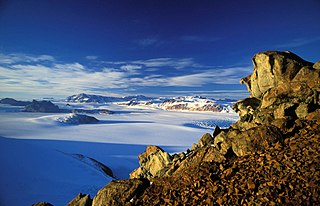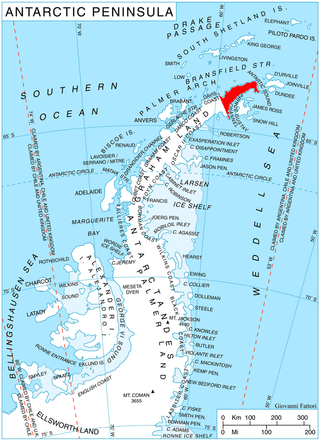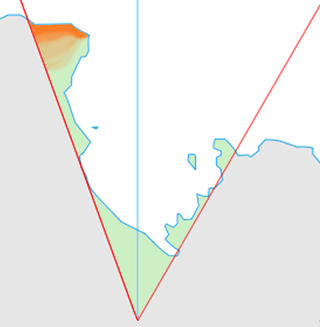Darwin most often refers to:
Starbucks is a chain of coffee shops.

The Transantarctic Mountains comprise a mountain range of uplifted rock in Antarctica which extends, with some interruptions, across the continent from Cape Adare in northern Victoria Land to Coats Land. These mountains divide East Antarctica and West Antarctica. They include a number of separately named mountain groups, which are often again subdivided into smaller ranges.
The Dennistoun Glacier is a glacier, 50 nautical miles long, draining the northern slopes of Mounts Black Prince, Royalist and Adam in the Admiralty Mountains of Victoria Land in Antarctica. It flows northwest between the Lyttelton Range and Dunedin Range, turning east on rounding the latter range to enter the sea south of Cape Scott. The coastal extremity of the glacier was charted in 1911–12 by the Northern Party, led by Victor Campbell, of the British Antarctic Expedition, 1910–13. The geographical feature lies situated on the Pennell Coast, a portion of Antarctica lying between Cape Williams and Cape Adare.

The Terra NovaExpedition, officially the British Antarctic Expedition, was an expedition to Antarctica which took place between 1910 and 1913. Led by Captain Robert Falcon Scott, the expedition had various scientific and geographical objectives. Scott wished to continue the scientific work that he had begun when leading the Discovery Expedition from 1901 to 1904, and wanted to be the first to reach the geographic South Pole.

The David Glacier is a glacier over 60 nautical miles long, flowing east from the polar plateau through the Prince Albert Mountains to the coast of Victoria Land, Antarctica. It enters Ross Sea between Cape Philippi and Cape Reynolds to form the floating Drygalski Ice Tongue. It is the most imposing outlet glacier in Victoria Land. It is fed by two main flows which drain an area larger than 200,000 square kilometres, with an estimated ice discharge rate of 7.8 +/- 0.7 km³/year. The David Glacier was discovered by Ernest Shackleton's "Northern Party," in November 1908, under the leadership of Prof. T.W. Edgeworth David, of Sydney University, for whom the feature was named.

Aitkenhead Glacier is a 10-mile (16 km) long glacier flowing east-southeast from the Detroit Plateau, Graham Land, into Prince Gustav Channel. It was mapped from surveys by the Falkland Islands Dependencies Survey (FIDS) (1960–61), and named by the United Kingdom Antarctic Place-Names Committee for Neil Aitkenhead, a FIDS geologist at Hope Bay (1959–60).
Pérez is a surname of either Spanish or Hebrew origin.

Boydell Glacier is a glacier on Trinity Peninsula in northern Graham Land. It is about 9 miles (14 km) long, flowing southeastward from Detroit Plateau to enter Sjögren Inlet in Prince Gustav Channel north of the terminus of Sjögren Glacier and 6 miles (10 km) west of Mount Wild. It was mapped by the Falkland Islands Dependencies Survey from surveys (1960–61), and named by the UK Antarctic Place-Names Committee for James Boydell, English inventor of a steam traction engine, the first practical track-laying vehicle.

Diplock Glacier is a narrow straight glacier, 10 miles (16 km) long, flowing eastward from Detroit Plateau, on Trinity Peninsula in Graham Land, into Prince Gustav Channel 5 miles (8 km) south of Alectoria Island. It is situated south of Marla Glacier and north of Zavera Snowfield. The feature was mapped from surveys by the Falkland Islands Dependencies Survey (1960–61), and was named by the UK Antarctic Place-Names Committee for Bramah Joseph Diplock, a British engineer who made considerable advances in the design of chain-track tractors (1885–1913).

Pennell Coast is that portion of the coast of Antarctica between Cape Williams and Cape Adare. To the west of Cape Williams lies Oates Coast, and to the east and south of Cape Adare lies Borchgrevink Coast. Named by New Zealand Antarctic Place-Names Committee (NZ-APC) in 1961 after Lieutenant Harry Pennell, Royal Navy, commander of the Terra Nova, the expedition ship of the British Antarctic Expedition, 1910–13. Pennell engaged in oceanographic work in the Ross Sea during this period. In February 1911 he sailed along this coast in exploration and an endeavor to land the Northern Party led by Lieutenant Victor Campbell.
Twin Nunataks are two small nunataks lying between Ricker Hills and Hollingsworth Glacier in the Prince Albert Mountains, Oates Land. Descriptively named by the Southern Party of the New Zealand Geological Survey Antarctic Expedition (NZGSAE), 1962–63.
The Mawson Glacier is a large glacier on the east coast of Victoria Land, Antarctica, descending eastward from the Antarctic Plateau to the north of Trinity Nunatak and the Kirkwood Range, to enter the Ross Sea, where it forms the Nordenskjöld Ice Tongue. The glacier was first mapped by the British Antarctic Expedition (1907–09) and named for Douglas Mawson, the expedition physicist, who later led two other Antarctic expeditions, 1911–14, and 1929–31.
Lashly Glacier is a short, broad glacier in Oates Land, Antarctica, lying between the Lashly Mountains on the west and Tabular Mountain and Mount Feather on the east, flowing south into The Portal, in Victoria Land. It was so named by the New Zealand party of the Commonwealth Trans-Antarctic Expedition (1956–58) for its proximity to the Lashly Mountains.

Dreatin Glacier is the 12 km long and 7.5 km wide glacier on the northeast side of Detroit Plateau on Trinity Peninsula in Graham Land, Antarctica. It lies southwest of Znepole Ice Piedmont and north of Aitkenhead Glacier, draining the area southwest of Mount Bradley and north of Tufft Nunatak, and flowing southeastwards into Prince Gustav Channel, Weddell Sea west of Marmais Point.

Marla Glacier is a glacier 8 nmi long and 1 nmi wide on the northeast side of Detroit Plateau on the southern Trinity Peninsula in Graham Land, Antarctica, situated south of Aitkenhead Glacier and north of Diplock Glacier. It is draining southeastwards along the east slopes of Povien Bluff, then turning east between Mount Roberts and Bezenšek Spur, and flowing into Prince Gustav Channel in Weddell Sea.





